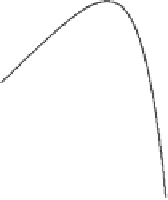Information Technology Reference
In-Depth Information
Equation (2) is an implicit function relating the voltage and current. To help with the
analysis, it can be shown that:
AKT
I
(3)
U
=
ln(1
+
)
− +
IR
U
s
oc
q
I
sc
Then, the output power of a PV cell is:
AKTI
I
(4)
2
PUI
==
ln(1
+ − +
)
IR IU
s
oc
q
I
sc
Equations (3) and (4)
can be used to produce output characteristic curve of the PV
cell.
When these series-parallel PV cells constitute a
N
S
×
N
P
array (
N
S
is the number
of PV cells in series, and
N
P
is the number in parallel), the corresponding PV array
output voltage, current, open circuit voltage, short-circuit current and series resistance
can be formulated as:
UNU
I NI
UNU
I
=
A
S
=
(5)
A
P
=
ocA
S
oc
=
NI
scA
P
sc
R
=
(
NNR
/
)
sA
S
P
s
Taking an array of
N
S
×
N
P
=3×2 PV as an example, Figure 2 and Figure 3 show the
I
-
V
curve and
P
-
V
curve respectively under the normal condition.
3000
1×1
2×1
3×1
4×1
5×1
6×1
6×3
18
1×1
2×1
3×1
4×1
5×1
6×1
6×3
2000
12
1000
6
0
0
0
50
100
150
200
250
300
0
50
100
150
200
250
300
Vpv / V
Vpv / V
a)
I
-
V
curve b)
P
-
V
curve
Fig. 2.
I
-
V
and
P
-
V
characteristic curve under normal condition
3.2
Output Characteristic of PV Array under Partially Shading Conditions
When the PV cells are operating in series, if the light is intense, the load current is
equal to the output current of each PV cell; if shadow appears on the surface of one or
more PV cells, their output currents are reduced, thus can easily cause Hot Spot
phenomenon, which will accelerate the aging of PV cells and even damage the
battery. So every PV cell has a bypass diode connected in parallel when PV cells
work in series. When one PV cell is under shading condition, it accepts less light
intensity, correspondingly produce smaller current; when the load demand current
















































































































































Search WWH ::

Custom Search